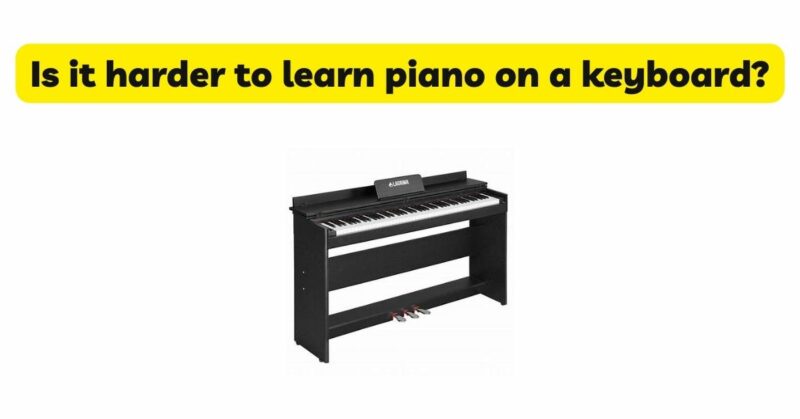Learning to play the piano is an exciting and rewarding journey that requires dedication, practice, and perseverance. When it comes to choosing an instrument, aspiring pianists often wonder whether it is harder to learn piano on a keyboard compared to an acoustic piano. In this article, we will explore the challenges that learners may encounter when using a keyboard and provide insights to help you navigate these obstacles effectively. While learning on a keyboard presents certain difficulties, it is important to remember that with the right mindset, approach, and practice, one can still achieve proficiency and musical expression.
- Touch Sensitivity and Key Action: One of the main challenges in learning piano on a keyboard lies in the touch sensitivity and key action. Acoustic pianos have mechanical action, where hammers strike strings, offering a tactile experience that responds to the player’s touch. This touch sensitivity is crucial for developing proper technique and control. While some keyboards attempt to replicate the touch of an acoustic piano with weighted keys and graded hammer action, they may not fully capture the nuances of touch response. The lack of authentic touch sensitivity can pose challenges when transitioning to playing on an acoustic piano, as it requires additional adjustment to adapt to the differences in key action.
- Sound Quality and Expression: Another significant challenge when learning on a keyboard is the sound quality and expression. Acoustic pianos produce a rich, resonant sound that is highly regarded for its depth and complexity. The harmonics and overtones created by the interaction of strings and soundboard contribute to the unique character of an acoustic piano. Keyboards, on the other hand, produce electronically generated sounds that aim to replicate the piano’s sound. While modern keyboards have made considerable advancements in sound sampling, the depth and authenticity of an acoustic piano’s sound are challenging to fully replicate. Consequently, learners may face difficulties in achieving the same level of tonal expression and dynamics on a keyboard.
- Technique Development: Developing proper technique is essential for playing the piano effectively and preventing injuries. Acoustic pianos require finger strength, agility, and a nuanced touch to control the sound and dynamics. The mechanical action of an acoustic piano demands a particular level of finger independence and control. Keyboards, especially those with lighter keys, may not provide the same resistance and feedback as acoustic pianos, which can impact the development of proper finger strength and control. However, with focused practice and attention to detail, learners can still work on technique development, including finger independence, articulation, and dynamic control, on a keyboard.
- Adjusting to Acoustic Pianos: If learners primarily practice on a keyboard and later transition to playing on an acoustic piano, they may face challenges in adapting to the acoustic instrument. The touch sensitivity, key action, and sound production of an acoustic piano require adjustment and acclimatization. The differences in touch response and sound projection can affect the overall playing experience and may require additional time and effort to adapt. However, with patience, practice, and guidance from an experienced piano teacher, learners can successfully make the transition and develop the necessary adjustments in technique and expression.
- Limited Sound Repertoire: Keyboards, especially entry-level models, may have a limited sound repertoire compared to acoustic pianos. While they often include sampled piano sounds, the variation and depth of sound options are generally more extensive in higher-end keyboards and digital pianos. Limited sound options can impact the exploration of different musical styles and genres, which can be a hindrance for learners seeking a broad musical experience. However, many keyboards do offer a range of additional instrument sounds and effects, which can still provide opportunities for creativity and musical exploration.
- Overcoming the Challenges: While learning piano on a keyboard presents certain challenges, it is important to approach these obstacles with a positive mindset and effective strategies. Here are some tips to overcome the difficulties:
a. Emphasize technique development: Focus on developing proper finger technique, hand position, and posture. Pay attention to the articulation, dynamics, and touch sensitivity even on a keyboard.
b. Seek guidance from a teacher: Enlist the support of an experienced piano teacher who can provide personalized instruction, guide you through technique adjustments, and help you bridge the gap between a keyboard and an acoustic piano.
c. Supplement with acoustic piano practice: Whenever possible, incorporate practice sessions on an acoustic piano to familiarize yourself with the touch, feel, and sound of the instrument. This will aid in adapting to the differences when transitioning between instruments.
d. Utilize technology and learning resources: Take advantage of the vast array of online resources, tutorials, and interactive learning platforms available. These tools can enhance your learning experience, provide guidance, and expose you to a wider range of musical styles.
e. Cultivate musical expression: Focus on developing your musicality and expression through careful attention to phrasing, dynamics, and interpretation. Even if the sound quality of a keyboard may not fully replicate an acoustic piano, musical expression can still be cultivated and refined.
Conclusion: While learning piano on a keyboard presents unique challenges compared to an acoustic piano, with dedication, practice, and effective strategies, learners can overcome these obstacles. Developing proper technique, adjusting to acoustic pianos, and refining musical expression may require additional effort and adaptation. However, the convenience, affordability, and technological advantages offered by keyboards make them a viable option for beginners and those with limited resources. Ultimately, the most crucial factor in learning piano is consistent practice and a passion for music. By embracing the challenges and adopting a positive approach, learners can achieve proficiency and musical expression regardless of the instrument they choose.


